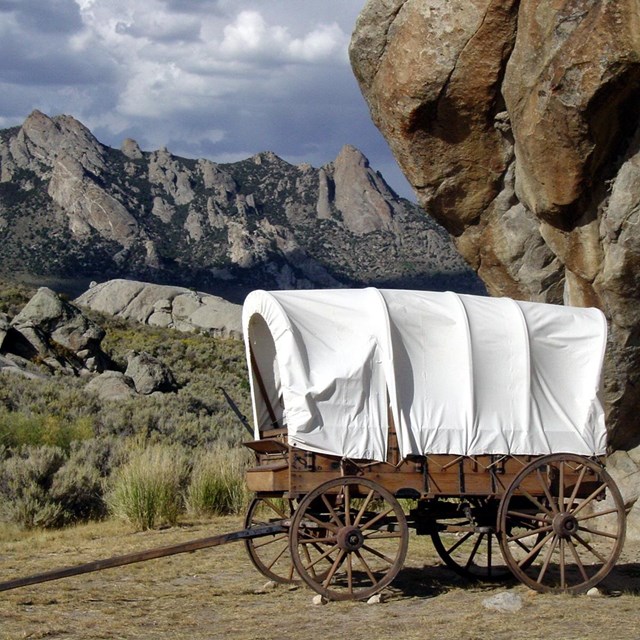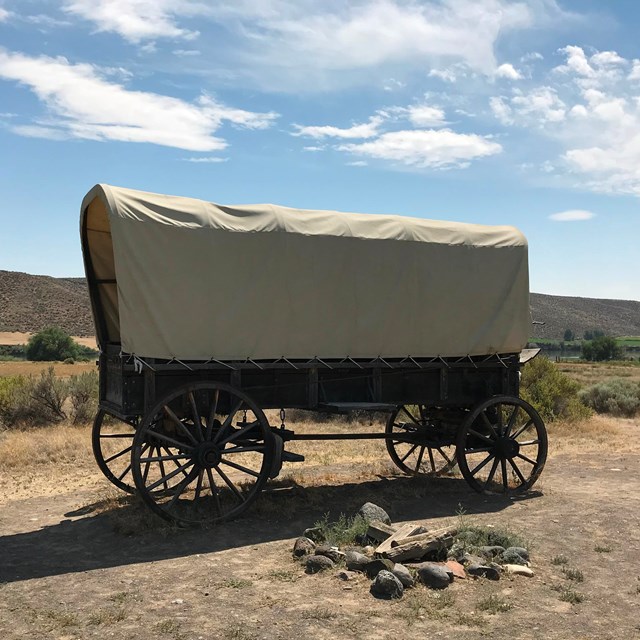Part of a series of articles titled The Emigrant Experience .
Article
Women Traveling West

The Oregon and California trails traverse lands where women challenged traditional gender roles. In the early 1840s Americans began heading west in large numbers, many traveling in family groups. Women in the nation’s more settled areas were supposed to excel at domestic work, like cooking, cleaning, and raising children; however, as part of a wagon train, women got to showcase a wider range of skills. One classic study of gender and work on the overland trails argues that, with each night on the trail, women stepped further outside their traditional domestic duties; while they remained responsible for food and laundry, they also gathered buffalo chips for fuel, drove teams of oxen, made bullets, and cared for the sick and injured.
Not all women went west as part of a family unit. The Homestead Act, passed in 1862, allowed “any person who is the head of a family, or who has arrived at the age of twenty-one years” to claim land for themselves. While most textbooks focus on the Act’s popularity with nuclear families, women—whether single, divorced, or widowed—could also be “head of a family”; one scholar estimated that, in the first 50 years of the Homestead Act, women accounted for one third of all homestead claims. The Morrill Act, also passed in 1862, pushed many states and territories in the West to establish land-grant colleges specializing in practical pursuits like agriculture. Although the act itself did not mention women, these new universities were far more accepting of female students than their private counterparts; in fact, land-grant colleges like Oregon State, Utah State, and the University of Nebraska became some of the first public schools in the world to promote coeducation. By 1872 the American West boasted 67 of the nation’s 97 coed schools.
In 1869, the Territory of Wyoming became the first American territory or state to grant women the right to vote—despite not having an organized suffrage movement like many places in the eastern United States. Why Wyoming, of all places? The explanation is equal parts practical and progressive. For one, very little time passed between the bill’s introduction and its passage, so anyone opposed had little time to organize. Secondly, there were very few women in Wyoming, leading a writer from Harper’s Weekly to compare the bill to a “vote to enfranchise angels or Martians.” Supporters of the bill also argued that women’s suffrage would entice good, stable families to move to Wyoming; in fact, the territorial secretary said that women had received the right to vote “solely for advertising purposes.” (Territories generally needed a certain number of people to apply for statehood.) However, the state legislature also voted to give teachers equal pay and married women control of their property, suggesting that some residents of Wyoming valued gender equality as more than just a promotional tool.
- Johnny Faragher and Christine Stansell, “Women and their Families on the Trail to California and Oregon, 1842-1867,” Feminist Studies 2, no. 2/3 (1975): 151-56.
- Holly J. McCammon and Karen E. Campbell, “Winning the Vote in the West: The Political Successes of the Women’s Suffrage Movements,” Gender and Society 15, no. 1 (February 2001): 67-68.
- Sandra Myres, Westering Women and the Frontier Experience, 1800-1915 (Albuquerque: University of New Mexico Press, 1982), 216, 219-21.
- Andrea Radke-Moss, Bright Epoch: Women and Coeducation in the American West (Lincoln: University of Nebraska Press, 2008), 1-6.
Last updated: March 12, 2021


